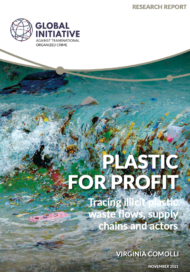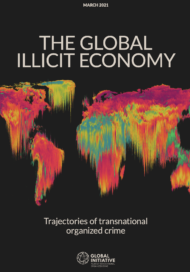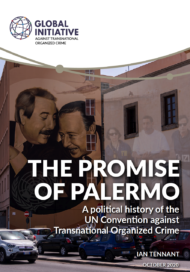Posted on 09 Mar 2022
The passing of a United Nations resolution in early March to curb plastic pollution is a historic step towards protecting the environment. It remains to be seen whether challenges, not least the presence of lucrative global illicit supply chains of plastic waste, might undermine its success.
Plastic pollution is at crisis level. The mass introduction of plastic in the 1950s and the associated culture of ‘throwaway living’ – an unthinkable catchphrase for today’s standards – together with more affordable production costs and the enormous versatility of plastic, have made the world over-reliant on this material. Today, to meet consumer demand and propelled by the petrochemical industry, we globally produce a staggering 460 million metric tonnes of plastic annually, 40% of which is for single use items.
Shockingly, only 20% of plastic waste is recycled, according to optimistic estimates. Others estimate the figure to be as low as 9%. This is due to inefficiencies and illegal practices in waste management, and the fact that some types of plastic cannot be recycled or it is too expensive to do so, especially in the face of cheaper approaches. As a result, plastic litter and microplastics are now major pollutants that can be found virtually everywhere – including in the Antarctic ice cap and the human body.
But plastic waste has an even darker side. Many legitimate businesses as well as criminal actors engage in the illicit trade of plastic waste, circumventing bans and conventions, and exporting hazardous plastic waste from producing countries, predominantly in the Global North to developing and emerging regions in Africa and Asia. In the absence of sophisticated processing facilities, the illegal dumping, burying and burning of plastic waste severely undermines ecosystems and human health.
The announcement of a global treaty on plastic pollution was understandably hailed as a landmark moment by policymakers and civil society groups that had long been campaigning for more robust anti-pollution efforts, particularly regarding plastics. On 2 March, 175 countries attending the United Nations Environment Assembly (UNEA) in Nairobi agreed on a resolution paving the way for the drafting, by the end of 2024, of a legally binding instrument aimed at ending plastic pollution. Crucially, the proposed treaty is not simply intended at ‘curing’ the symptoms of pollution. The goal is to address the entire plastic lifecycle, from production to disposal, and to shift the focus from recycling to promoting a circular economy approach to plastics and eliminating single-use plastic.
Challenges, oil companies and lobbies
The life journey of the humble plastic bottle starts with fossil fuel extraction, which generates the most important plastic feedstock. The shale-gas boom in the US has made the production of fossil fuels so cheap that producing new plastic is often considerably more affordable than processing and recycling plastic waste into pellets. This not only highlights the economic disincentive for recycling, but also explains why the petrochemical industry – despite supportive public statements – is likely to undermine the drafting of a robust treaty.
Based on current trends, plastic production is expected to double over the next 20 years and any measures aimed at curtailing it are going to hurt the manufacturing industry. Over the years, industry associations have lobbied both plastic producer and consumer countries. Notably, in 2020, the American Chemistry Council (ACC) lobbied the US government to shape the terms of the planned US–Kenya trade deal in order to stop the imposition of limits on both the production and use of plastic. The ACC, which represents American oil and chemical firms, had also been intensively lobbying countries ahead of the recent UNEA meeting in Kenya, emphasizing the benefits of plastic and trying to convince member states not to agree on any legally binding restrictions on plastic production.
The adoption of the resolution was a stern signal to the plastics industry that things need to change and that the current model is unsustainable and no longer acceptable. Yet, it would be disingenuous to expect the ACC or its European counterpart, Plastics Europe, to sit back and not influence the drafting of the treaty over the next couple of years. The treaty will contain both binding and voluntary measures, and it is likely that efforts will be made by industry to resist any caps on production under the former.
Disposal and illegality
At the other end of plastic’s lifecycle is disposal. And this phase presents another challenge that should not be ignored. Illegal practices are pervasive along the entire plastic-waste supply chain, involving a number of actors across multiple jurisdictions. As they move unwanted plastic waste from wealthy consumer markets to often unregulated dumping destinations, the perpetrators engage in an array of white-collar crimes that infringe national and international regulations, including the Basel Convention on the Control of Transboundary Movements of Hazardous Wastes and their Disposal, the instrument controlling the majority of plastic-waste shipments across the world.
An inherent characteristic of criminal actors is their ability to identify loopholes, adopt creative solutions to play the system and adapt to the changing regulatory and legislative environment. In the waste sector, this has amounted to concealment, forgery and fraud, and exploiting weaknesses such as poor surveillance, willingness to accept bribes and the presence of vulnerable workers.
It is imperative that the design of the new treaty takes into account these risks and the fact that unscrupulous actors will be ready to adopt new tactics to continue to profit from the waste business despite the introduction of new regulations. Such risks will be particularly acute for developing and emerging economies, which are already the most severely affected by the pollution crisis and illicit-waste disposal. They will need the means, both financial and technological, to ensure the effective implementation of the new treaty. And this raises a question that will most likely be a key point for debate during the treaty process: who is going to shoulder the financial burden of implementing the new standards?



